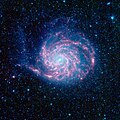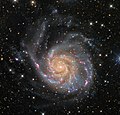Messier 101
| Galaxie Messier 101 | |
|---|---|
(c) ESA/Hubble, CC BY 4.0 | |
| Foto der Spiralgalaxie Messier 101 vom Hubble-Weltraumteleskop | |
| AladinLite | |
| Sternbild | Großer Bär |
| Position Äquinoktium: J2000.0, Epoche: J2000.0 | |
| Rektaszension | 14h 03m 12,5s [1] |
| Deklination | +54° 20′ 56″ [1] |
| Erscheinungsbild | |
| Morphologischer Typ | SAB(rs)cd[1] |
| Helligkeit (visuell) | 7,5 mag[2] |
| Helligkeit (B-Band) | 8,2 mag[2] |
| Winkelausdehnung | 28,8′ × 26,9′[2] |
| Positionswinkel | 26°[2] |
| Flächenhelligkeit | 14,6 mag/arcmin²[2] |
| Physikalische Daten | |
| Zugehörigkeit | LGG 371[3] |
| Rotverschiebung | 0,000804 ± 0,000007[1] |
| Radialgeschwindigkeit | (241 ± 2) km/s[1] |
| Hubbledistanz H0 = 73 km/(s • Mpc) | (22 ± 2) · 106 Lj (6,6 ± 0,7) Mpc [4] |
| Durchmesser | 170.000 Lj[5] |
| Geschichte | |
| Entdeckung | Pierre Méchain |
| Entdeckungsdatum | 27. März 1781 |
| Katalogbezeichnungen | |
| M 101 • NGC 5457 • UGC 8981 • PGC 50063 • CGCG 272-21 • MCG +9-23-28 • IRAS 14013+5435 • 2MASX J14031258+5420555 • Arp 26 • VV 344 • VV 456 • GC 3770 • h 1744 • Kara 610 | |
Messier 101 oder M101 (nach dem Messier-Katalog), auch als NGC 5457 bezeichnet und Feuerradgalaxie (englisch Pinwheel Galaxy) genannt, ist eine Spiralgalaxie im Sternbild Großer Bär, die mit einer scheinbaren Größe von 28,8′ × 26,9′ und scheinbarer Helligkeit von 7,5 mag erscheint. Ihre Entfernung zur Erde beträgt rund 22 Millionen Lichtjahre, ihr Durchmesser 170.000 Lichtjahre. Damit ist sie ungefähr so groß wie unsere Milchstraße.
M101 hat fünf prominente Begleitgalaxien: NGC 5204, NGC 5474, NGC 5477, NGC 5585 und Holmberg IV[6].
Beobachtungsgeschichte
Messier 101 wurde am 27. März 1781 von dem französischen Astronomen Pierre Méchain entdeckt, der Charles Messier die Position des Objektes mitteilte. Messier nahm die in seinerzeitigen Teleskopen einem Kometen ähnliche, aber ortsfeste Erscheinung im gleichen Jahr in die endgültige Version seines Kataloges auf. Diverse helle Knoten von M101, bei denen es sich um H-II-Gebiete und/oder Sternwolken handelt, wurden später unter separaten Einträgen unter anderem in den New General Catalogue of Nebulae and Clusters of Stars (NGC) verzeichnet.[7]
In dem in den 1960er Jahren erstellten Halton Arps Katalog ungewöhnlicher Galaxien wurde M101 im Abschnitt Spiralgalaxien mit ausgeprägtem Arm aufgeführt.
Im Jahr 2006 veröffentlichten NASA und ESA ein sehr eindrucksvolles Bild, das größte und detaillierteste einer Galaxie, das mithilfe des Hubble-Weltraumteleskops angefertigt wurde.[8] Dieses Bild war aus über 51 Aufnahmen zusammengesetzt worden.
Am 24. August 2011[9] wurde in M101 eine Supernova vom Typ Ia entdeckt, welche die Bezeichnung SN 2011fe[10] erhielt.
Am 19. Mai 2023 wurde in M101 eine weitere Supernova vom Typ II entdeckt: SN 2023ixf.[11][12]
Einzelobjekte in M101
| Name des Objektes[13] | Rektaszension | Deklination | mV | Entdecker | Entdeckungsdatum |
|---|---|---|---|---|---|
| HK 461=HK 465 | 14h 02m 23.9s | +54° 17′ 47″ | |||
| NGC 5449 | 14h 02m 28.1s | +54° 19′ 50″ | 14 | Bindon Blood Stoney | 27. April 1851 |
| NGC 5447=NGC 5450 | 14h 02m 28.3s | +54° 16′ 32″ | 13,5 | Bindon Blood Stoney | 27. April 1851 |
| NGC 5451 | 14h 02m 36.6s | +54° 21′ 49″ | 14 | Bindon Blood Stoney | 27. April 1851 |
| HK 371 | 14h 02m 54.3s | +54° 16′ 26″ | 13,8 | ||
| NGC 5453 | 14h 02m 56.7s | +54° 18′ 20″ | 13,8 | Bindon Blood Stoney | 27. April 1851 |
| NGC 5455 | 14h 03m 01.2s | +54° 14′ 27″ | 13 | Bindon Blood Stoney | 27. April 1851 |
| HK 309=HK 314 | 14h 03m 02.2s | +54° 20′ 03″ | 13,9 | ||
| NGC 5458 | 14h 03m 12.5s | +54° 17′ 55″ | 14 | Bindon Blood Stoney | 27. April 1851 |
| HK 103 | 14h 03m 27.2s | +54° 18′ 45″ | |||
| HK 70 | 14h 03m 30.6s | +54° 20′ 38″ | |||
| HK 60 | 14h 03m 32.4s | +54° 17′ 21″ | |||
| HK 59 | 14h 03m 33.8s | +54° 20′ 26″ | |||
| NGC 5461 | 14h 03m 39.7s | +54° 18′ 56″ | 14 | William Herschel | 14. April 1789 |
| HK 20 | 14h 03m 49.4s | +54° 27′ 38″ | |||
| NGC 5462 | 14h 03m 53.5s | +54° 22′ 02″ | 13,5 | William Herschel | 14. April 1789 |
| H 1216 | 14h 04m 12.4s | +54° 25′ 27″ | |||
| NGC 5471 | 14h 04m 29.1s | +54° 23′ 49″ | 14,7 | Heinrich d’Arrest | 22. August 1863 |
Abbildungen
- Ultraviolettaufnahme des GALEX
- Infrarotaufnahme des Spitzer-Weltraumteleskop
- Infrarotaufnahme durch das Teleskop Herschel
- Aufnahme durch das Gemini-Teleskop mit 8 Meter Hauptspiegeldurchmesser; darin links unten die Supernova 2023ixf
- Amateuraufnahme von M101
- Fotografische Aufnahme mit Beschriftung einiger prägnanter Himmelsobjekte in der Umgebung der Galaxie M101. Im Viertel unten rechts ist das Ende der Deichsel des Großen Wagens im Sternbild Großer Bär mit den Sternen Mizar, Alkor und Alkaid zu sehen. Im linken unteren Viertel befindet sich das Sternbild Bärenhüter (Bootes), und im oberen Bildteil grenzt das Sternbild Drache an.
Literatur
- König, Michael & Binnewies, Stefan (2019): Bildatlas der Galaxien: Die Astrophysik hinter den Astrofotografien, Stuttgart: Kosmos, S. 92
Weblinks
- M101 bei SEDS
- Hubble image of M101. In: ESA/Hubble website. 10. Februar 2009 (englisch).
- Im Bann des Feuerrades - M101 visuell ( vom 1. Juli 2009 im Internet Archive)
- Sternexplosion bereits wenige Stunden nach Ausbruch beobachtet. In: Welt der Physik. 12. August 2011.
- Spektrum.de: Amateuraufnahmen [1][2][3][4][5][6]
- Spektrum.de: Umgebungskarte
- Arp Atlas of Peculiar Galaxies
- Seligman Arp
- CDS Portal
Einzelnachweise
- ↑ a b c NASA/IPAC Extragalactic Database
- ↑ a b c d e SEDS: NGC 5457
- ↑ VizieR
- ↑ Shappee, Benjamin & Stanek, Kris (2011): A New Cepheid Distance to the Giant Spiral M101 Based on Image Subtraction of Hubble Space Telescope/Advanced Camera for Surveys Observations. In: Astrophysical Journal 733(2), S. 124.
- ↑ NASA/IPAC
- ↑ engl. WP
- ↑ Seligman
- ↑ Hubble's largest Galaxy portrait offers a new high-definition view. In: Hubblesite.org. 28. Februar 2006, abgerufen am 25. Januar 2022.
- ↑ The Astronomers Telegramm: https://www.astronomerstelegram.org/?read=3581
- ↑ The Astronomers Telegramm: https://www.astronomerstelegram.org/?read=3597
- ↑ SN 2023ixf | Transient Name Server. Abgerufen am 20. Mai 2023.
- ↑ Franziska Bechtold: Supernova Messier 101: So könnt ihr den explodierten Stern sehen. In: Futurezone. 27. Mai 2023, abgerufen am 28. Mai 2023.
- ↑ Ronald Stoyan: Atlas der Messier-Objekte. Oculum-Verlag, Erlangen 2006, ISBN 978-3-938469-07-1
Auf dieser Seite verwendete Medien
Bildtafel der 110 Messier-Objekte. Diese Datei wird in der w:de:Template:Navigationsleiste Messierobjekte als Imagemap genutzt. Sie darf daher nicht durch eine andere Version überschrieben werden!
The tangled arms of the Pinwheel galaxy, otherwise known as Messier 101, are decked out in red in this new infrared image from NASA's Spitzer Space Telescope.
The Pinwheel galaxy is located 27 million light-years away in the constellation Ursa Major. It is what's called a flocculent spiral, which means that its spiral arms are not well defined.
The red color shows the dust, while the blue glow around the galaxy is from starlight.
In this infrared composite, blue indicates light with a wavelength of 3.6 microns, green corresponds to 4.5 microns, and red to 5.8 and 8.0 microns. The contribution from starlight (measured at 3.6 microns) has been subtracted from the 5.8- and 8-micron images to enhance the visibility of the dust features.Autor/Urheber: Fabian RRRR (talk) 22:21, 5 October 2012 (UTC) / ESA, Lizenz: CC BY-SA 3.0
Messier 101 observed in the far infrared by Herschel.
Herschel is an ESA space observatory with science instruments provided by European-led Principal Investigator consortia and with important participation from NASA.
The observations performed with the ESA Herschel Space Observatory (Pilbratt et al. 2010), in particular employing Herschel's large telescope and powerful science instrument SPIRE (Griffin et al. 2010).
Pilbratt, G.L., Riedinger, J.R., Passvogel, T. et al. 2010, A&A, 518, L1
Griffin, M.J., Abergel, A., Abreu, A. et al. 2010, A&A, 518, L3Autor/Urheber:
International Gemini Observatory/NOIRLab/NSF/AURA Image Processing: J. Miller (Gemini Observatory/NSF’s NOIRLab), M. Rodriguez (Gemini Observatory/NSF’s NOIRLab), M. Zamani (NSF’s NOIRLab), T.A. Rector (University of Alaska Anchorage/NSF’s NOIRLab) & D. de Martin (NSF’s NOIRLab). Astronomical processing done with DRAGONS 3.1.
, Lizenz: CC BY 4.0Gemini North, part of the International Gemini Observatory operated by NSF’s NOIRLab, is back observing the night sky following the repair and refurbishment of its primary mirror. The telescope’s debut observation captured the supernova dubbed SN 2023ixf (lower left), which was discovered on 19 May by Japanese astronomer Koichi Itagaki. This dazzling point of light, the closest supernova seen in the past five years, is located along one of the spiral arms of the Pinwheel Galaxy (Messier 101).
(c) ESA/Hubble, CC BY 4.0
The galaxy Messier 101 (M101, also known as NGC 5457 and also nicknamed the Pinwheel Galaxy) lies in the northern circumpolar constellation, Ursa Major (The Great Bear), at a distance of about 21 million light-years from Earth. This is one of the largest and most detailed photos of a spiral galaxy that have been released from Hubble. The galaxy's portrait is actually composed of 51 individual Hubble exposures, in addition to elements from images from ground-based photos. A high-res version with 15852 x 12392 pixels in jpg and tiff format is also available, see below for url.
Autor/Urheber: Giuseppe Donatiello, Lizenz: CC0
Collective image obtained with the contribution of the following amateur astronomers (in alphabetical order): Paolo Demaria, Giuseppe Donatiello, Mark Elvov, Andrew Genualdi, Zlatko Orbanic, Rolando Ligustri, Andrea Pistocchini, Tim Stone.
All rights reserved. Reproduction and publication permitted with the obligation to list all Authors.Autor/Urheber: Donald Pelletier, Lizenz: CC BY-SA 4.0
Image created using the Aladin Sky Atlas software from the Strasbourg Astronomical Data Center and SDSS (Sloan Digital Sky Survey) public data.
The structural integrity of M101, or the Pinwheel Galaxy, is revealed in this classic image from GALEX.
Unlike our closest large galactic neighbor, the Andromeda galaxy, both young and old stars are evenly distributed along M101's tightly wound spiral arms. Blue shows the presence of hot, young stars that formed about 10 million years ago, and regions that glow yellow harbor older, cooler stars that are over 100-million years old.
M101 stretches twice the diameter of our Milky Way galaxy, and is located approximately 27 million light-years away in the constellation Ursa Major. Structural Integrity of the Pinwheel Galaxy
This image of the Pinwheel Galaxy is a two-color composite, where far-ultraviolet light is blue, and near-ultraviolet light is red.Autor/Urheber: Bautsch, Lizenz: CC0
Fotografische Aufnahme mit Beschriftung einiger prägnanter Himmelsobjekte in der Umgebung der Galaxie M 101. Unten rechts ist das Ende der Deichsel des Großen Wagens im Sternbild Großer Bär mit den Sternen Mizar, Alkor und Alkaid zu sehen. Links unten befindet sich das Sternbild Bärenhüter (Bootes), und im oberen Bildteil grenzt das Sternbild Drache an.



















